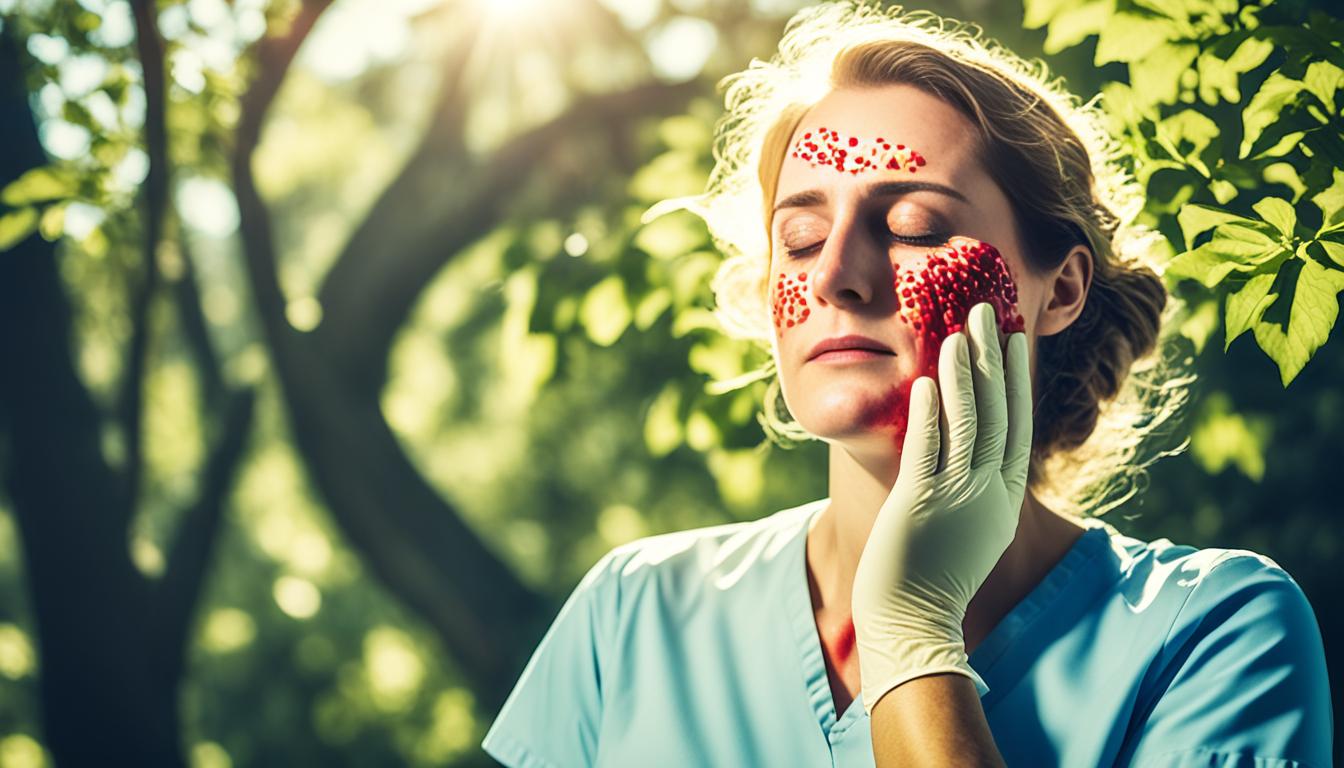Polymorphous light eruption (PLE) is a common skin issue. It shows as a rash on areas hit by the sun after sun exposure. This problem often bothers people with fair skin, especially young women. Yet, it can happen to anyone regardless of age, gender, or race.
There are different forms of PLE, with skin issues like bumps, fluid-filled blisters, or bleeding into the skin. Despite the form, these skin problems look alike in the same person. Fortunately, the rash usually goes away within a few days and doesn’t scar the skin.
The exact cause of PLE isn’t clear. It likely involves a reaction in the skin to sunlight’s effects on certain skin proteins. Doctors diagnose PLE by looking at the skin’s response to sun but also need to make sure it’s not other skin problems, like solar urticaria or some types of lupus.
Currently, there’s no definite cure for PLE. People can manage it by protecting their skin from the sun with clothing and sunscreen. Treatments such as phototherapy and certain medicines can also help make the skin less sensitive to light. Using stem cell therapy is a new and hopeful idea for treating PLE, but it still requires more study to prove how well it works.
Key Takeaways:
- PLE is a common condition that causes a rash on sun-exposed skin after intense sunlight exposure.
- It primarily affects fair-skinned individuals, particularly young females.
- Different clinical variants of PLE exist, with skin lesions that are typically monomorphic.
- Diagnosis is based on clinical presentation and ruling out other conditions with similar symptoms.
- Treatment options include protective measures, phototherapy, and photochemotherapy.
Clinical Features of Polymorphous Light Eruption
Polymorphous light eruption (PLE) is common in people with light skin, especially young women. The rash shows up on skin that gets sunlight. It comes in different forms like bumps, blisters, or red patches.
These skin issues look the same on the same person each time, which helps doctors spot PLE. It often starts with itching, then turns into red patches and sores that might join together.
It usually goes away without scarring after a few days. But, it might come back over many years, usually when the weather gets sunny again. With more time in the sun, these rashes might not be as bad.
To give you a visual representation, here is a table summarizing the clinical variants of PLE:
| Clinical Variant | Description |
|---|---|
| Papular | Small, raised bumps on the skin |
| Vesiculo-bullous | Blisters or bullae filled with fluid |
| Plaque | Large, elevated patches of skin |
| Erythema multiforme-like | Target-like lesions with concentric rings |
To visually understand the clinical features of PLE, take a look at this image:
These different forms help doctors know someone has PLE. In the next part, we’ll look more at how they figure this out and how it’s different from other skin conditions.
Diagnosis and Differential Diagnosis of Polymorphous Light Eruption
The diagnosis of polymorphous light eruption (PLE) relies on how it looks and its link to rash after strong sun exposure. People often mention an order of things, starting with itchiness, redness, and then development of unique spots. These signs set PLE apart from other rashes.
It’s key to tell PLE apart from other similar skin reactions. Doctors must exclude the following differential diagnoses:
- Solar urticaria: typified by hives or wheals and feeling hot or itchy after being in the sun. PLE differs by not showing an immediate allergic response.
- Photosensitive erythema multiforme: manifests as target-shaped or blistering skin spots, akin to PLE. But, it usually comes with infections or is drug-caused.
- Lupus erythematosus: an autoimmune condition that might look like PLE after sun exposure. Unlike PLE, lupus can cause body-wide symptoms and harm multiple organs.
Sometimes, telling PLE from these issues isn’t easy due to similar symptoms. Extra tests like skin biopsy and phototesting may be needed. These tests can shed light on the rash causes.
By making a correct PLE diagnosis and negating other possibilities, doctors can set up fitting treatment plans. This care is tailored to each patient’s unique situation.
Conclusion
Polymorphous light eruption (PLE) is a common skin problem triggered by the sun. It appears as a rash on areas where sunlight hits strongly. The cause of PLE is not entirely known, but it may be due to the skin reacting badly to sunlight.
While a direct cure for PLE is not yet available, managing the symptoms is possible. This can be done through different treatments. These options help control the skin’s reaction to sunlight.
Protecting your skin with sunscreen and clothes can lower the chance of a reaction. Also, certain light therapies can make the skin less sensitive to light. These methods work to prevent or lessen the rash caused by sun exposure.
Another promising way to treat PLE is through stem cell therapy. This method uses the body’s own repair cells to heal the skin. It may offer a longer-lasting solution for those suffering from PLE. But, the safety and effectiveness of this therapy need more study.
Living with PLE can be tough, but treatments and lifestyle changes can help a lot. By avoiding the sun and using the right precautions, the symptoms can be reduced. New therapies, like stem cell treatment, offer hope for a better life without the constant fear of the sun.

